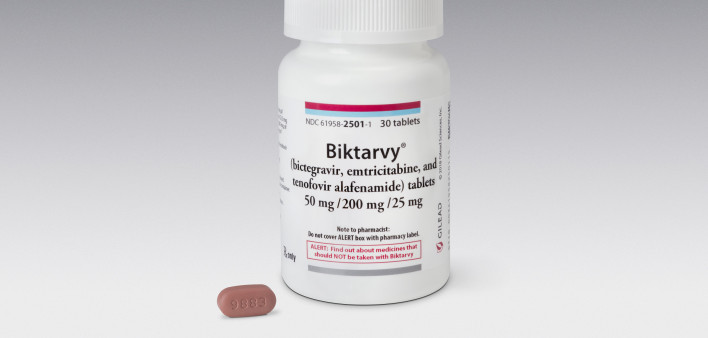Gilead Sciences’ Biktarvy (bictegravir/tenofovir alafenamide/emtricitabine) proved highly effective at suppressing HIV among women after 96 weeks and among those with drug-resistant virus after 48 weeks in a pair of recent studies.
Findings from the trials were presented at the 10th International AIDS Society Conference on HIV Science in Mexico City (IAS 2019).
Currently, Biktarvy is approved to treat HIV in adults or children who weigh at least 25 kilograms (55 pounds) and who have not previously been treated with antiretrovirals (ARVs) or who switch from a stable ARV regimen and have a fully suppressed viral load. Biktarvy is not approved for those whose virus has resistance to any of the three medications included in the regimen.
Cissy Kityo, MD, MSc, of the Joint Clinical Research Centre in Kampala, Uganda, presented findings from one study, which was an international, multicenter, randomized, open-label Phase III trial of 470 women who upon enrollment had a fully suppressed viral load and were taking either Genvoya (elvitegravir/cobicistat/tenofovir alafenamide/emtricitabine) or Norvir (ritonavir)-boosted Reyataz (atazanavir) plus Truvada (tenofovir disoproxil fumarate/emtricitabine). The women were evenly randomized to switch to Biktarvy or remain on their initial ARV regimen.
The study was conducted in Uganda, Russia, Thailand, the United States and the Dominican Republic.
Overall, participants had an average age of 40 years old. Thirty-seven percent were Black, 28% were white, 22% were Asian and 15% were Latino. The average CD4 count at the study’s outset was 701.
The 48-week findings from the study were previously reported. They indicated that Biktarvy’s ability to suppress HIV was comparable, or noninferior, to Genvoya and also to boosted Reyataz plus Truvada. The women experienced a low rate of serious adverse health events, and none saw their virus develop resistance.
At the 48-week point, all participants who had not already done so switched to Biktarvy. At week 96 of the study, 99.5% of those who switched to Biktarvy at the outset of the trial had a fully suppressed viral load, compared with 98.5% of those who switched at week 48. There was still no emergence of drug-resistant virus.
Biktarvy was still well tolerated; the women maintained a low rate of serious adverse health events. The most common adverse events experienced by at least 10% of participants were upper respiratory tract infection, the common cold, headache and urinary tract infection.
Paul E. Sax, MD, of Brigham and Women’s Hospital and Harvard Medical School in Boston, presented the second study, which is ongoing: a randomized, double-blinded Phase III trial including 565 people who started the trial with a fully suppressed viral load and who were taking Tivicay (dolutegravir) plus either Truvada (tenofovir disoproxil fumarate/emtricitabine) or Descovy (tenofovir alafenamide/emtricitabine). Just as in the other trial, they were randomized into even groups to stay on their initial regimen or switch to Biktarvy for 48 weeks of treatment.
This trial represented the first investigation of Biktarvy that admitted participants with virus that was resistant—specifically to nucleoside/nucleotide reverse transcriptase inhibitors (NRTIs), non-nucleoside reverse transcriptase inhibitors (NNRTIs) or protease inhibitors but not to integrase inhibitors. Twenty-four percent of the participants had viral resistance to NRTIs.
The analysis presented in Mexico City focused on the 284 people taking Biktarvy and the 281 taking Tivicay plus Descovy. The median age of the participants was a respective 51 and 50 years old in the two groups. A respective 86% and 85% were male, and a respective 71% and 72% were white. They began the study with median CD4 counts of 659 and 642, respectively.
After 48 weeks of treatment, 0.4% (1 of 284) of those who switched to Biktarvy had a viral load of 50 or greater, compared with 1.1% (3 of 281) of those who stayed on Tivicay plus Descovy. This indicated that Biktarvy’s efficacy was noninferior to that of Tivicay plus Descovy. A respective 93% (265 of 284) and 91% (256 of 281) had a fully suppressed viral load.
None of the participants experienced treatment-emergent drug resistance during the 48-week period, and none of those who entered the study with NRTI-resistant virus had a viral load greater than 50 at the end of the period.
To read the Biktarvy in women abstract, click here.
To read the Biktarvy resistance abstract, click here.
To read a press release about the studies, click here.







Comments
Comments